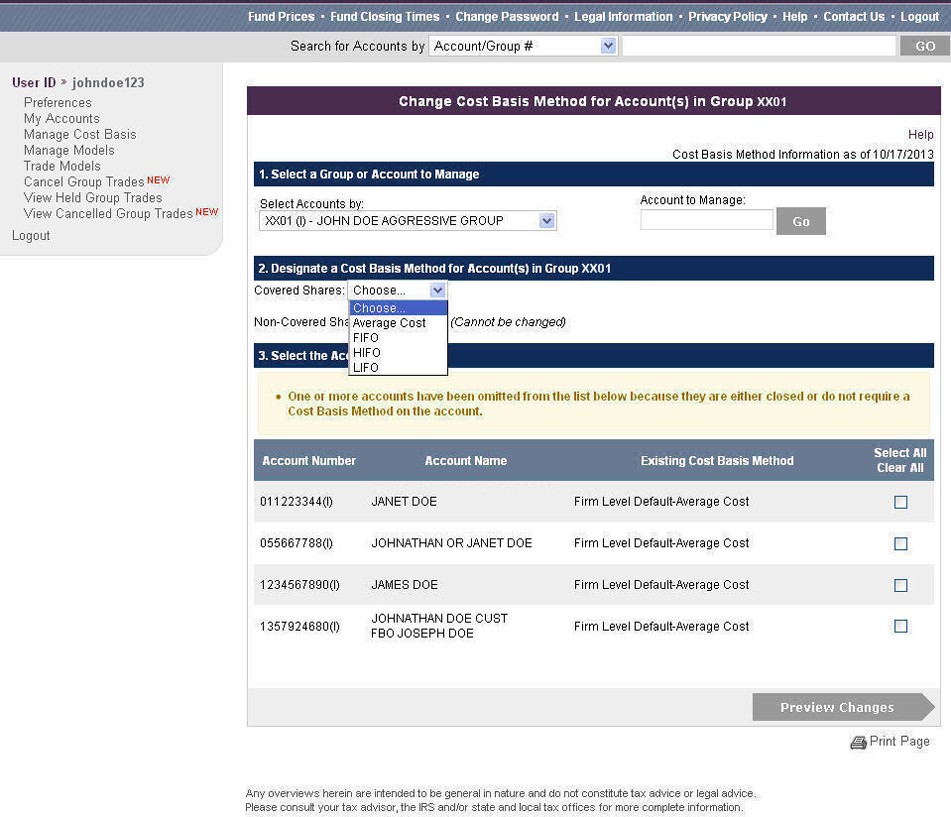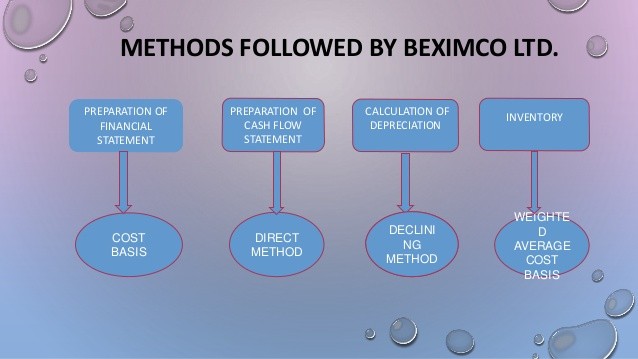Cost basis methods
Post on: 11 Июнь, 2015 No Comment

If you sell shares of a stock. bond. exchange-traded fund (ETF), or mutual fund in a taxable account, you pay a capital-gains tax on the difference between the basis (what you paid, with adjustments) and the sales price (what you sold it for). These transactions are reported in IRS Form 8949: basis is reported in Column (f), Cost or other basis ; sales price is reported in Column (e), Sales price.
You must choose an accounting method for each fund you hold in order to determine the basis. IRS Publication 550 [1] describes the three allowed methods for mutual funds. The methods are of one of two types: cost basis methods and average basis methods. (You may not use average basis methods for individual stocks or ETFs.) In a cost basis method, every share has its own basis, and the accounting method determines which share you sell. In an average basis method, the basis of a group of shares is averaged over all the shares.
For stocks purchased in 2011 or later, and mutual funds and most ETFs purchased in 2012 or later, the brokerage or mutual fund company is required to do the accounting according to one of these methods, and report data to the IRS; for earlier purchases, the brokerage will not report to the IRS, but you still need to keep your own records in order to report the data on your own tax form. Mutual fund shares bought before 2012 are called noncovered shares, while those bought in 2012 or later are called covered shares. [2]
The examples in this page show the different tax effects in the following sample situation:
- Ten years ago, you bought 100 shares at $30.
- Five years ago, you bought 100 shares at $40.
- Six months ago, you bought 100 shares at $50.
- Two months ago, you bought 100 shares at $60.
- Today, you want to sell 100 shares at $60.
Contents
FIFO (first in, first out)
In this method, the first shares purchased are assumed to be the shares sold. In the example above, you sell the shares bought ten years ago; since you bought them for $3,000, your basis is $3,000, and your capital gain is $3,000.
This is the default accounting method; the IRS assumes that you used it unless you have records to support another method. If you have not given your brokerage other instructions and you say Sell 100 shares without identifying which 100 shares, the shares will be FIFO. This method is the simplest, but it usually leads to the largest tax bills if you use it for stock funds, because shares tend to rise in value and the oldest shares will usually be the ones bought for the lowest price.
Specific share identification
In this method, you may choose which shares to sell. You must be able to adequately identify the shares sold. You may have a standing order such as Sell highest-cost shares first or Sell lowest-cost shares first; Vanguard, for example, allows you to specify HIFO (highest-in-first-out) for an account. You may also provide specific identification with every transaction. If you identify a specific transaction, the IRS says that you can do this if you specify the shares sold to the agent (the broker or mutual fund company) when you make the sale (up to the settlement date, which is three days after the sale date for most stocks), and receive written confirmation from the agent selling the shares. In the example above, you could choose to sell the 100 shares bought two months ago; your basis in those shares is $6,000, so you have a zero capital gain.

If you hold stock certificates (very rare for mutual funds, and no longer common even for individual stocks), then you specify which shares to sell by which certificate you give to the broker for the sale.
This method requires the most record-keeping (particularly if your brokerage doesn’t make it easy, and Vanguard did not make it easy until the new IRS requirements came into effect), but it allows you to minimize your tax bills, and the tax savings can be very large. See Specific identification of shares for more information about the advantages, and details of how to use this method with Vanguard.
Average basis
In this method, all of your shares in a mutual fund have the same basis, which is the average cost (or other basis) of all shares at the time they were purchased (adjusted for previous sales followed by subsequent purchases). Shares are still sold in the order purchased. In the example above, you paid $18,000 for 400 shares, so your average basis is $45 a share; when you sell 100 shares at $60, your basis is $4500, your sales price is $6000, and the capital gain is $1,500. It is a long-term gain since you sold the shares you bought ten years ago.
Once you have averaged shares, they remain averaged for future transactions. In the example above, your basis is $45 in all 300 remaining shares; if you change to specific identification in the future, you cannot sell shares with a $30 or $60 basis.
For mutual fund shares bought before 2012, and as an option in the future, Vanguard provides the records for using this method. If you use another method, you need to ignore Vanguard’s reported gains on the confirmations you receive. Vanguard considers covered and noncovered shares as being in separate accounts and computes the average for covered shares independently from the average for noncovered shares. [3] [note 1]
There was a double-category method which allowed you to separate short-term and long-term gains, but the IRS eliminated that method on April 1, 2011.
Choosing a method
You must tell your custodian (the brokerage or fund company which holds the assets) which accounting method to use. The brokerage can allow you to use a choice other than the standard choices, such as highest-in-first-out; if you use such a choice, you are effectively using specific identification, but giving a standing order to the brokerage, Always sell the shares with the highest cost. (This option usually minimizes taxes, but you may need to override the decision to minimize taxes in some situations; for example, you might have a $2,000 short-term gain on the highest-cost shares and a $3,000 long-term gain on the lowest-cost shares.) Vanguard’s default choice is average basis for mutual funds and FIFO for stocks.
If you owned mutual funds before Vanguard was required to keep track of the basis, your old shares will be assigned an average basis in Vanguard’s records; Vanguard does not allow you to specify a basis in its records, but you can specify it when you sell. If you owned stocks which were not bought at Vanguard Brokerage (including ETF shares converted from Vanguard funds), you can enter the basis yourself.
Changing methods
In 2011, you were required to use the same method for each fund even if the fund is held in multiple accounts. Starting in 2012, you are allowed to use average basis and other methods for different accounts even in the same fund. You may also change accounting methods at any time. Thus, if you made your first sale as FIFO, you may specifically identify another sale as long as you do not sell the shares already sold. If you change to another method from average-basis, all shares keep their average basis (i.e. they retain the basis computed prior to the change).
You may also choose to use different methods for different funds held in the same account; for example, you might use FIFO or average basis for a bond fund (for which the methods make little difference) and specific identification for a stock fund.
Cautions
There are some complications to the computation of basis and some restrictions on taking of losses. See the links below for more information, and do not treat this wiki page as tax advice.














